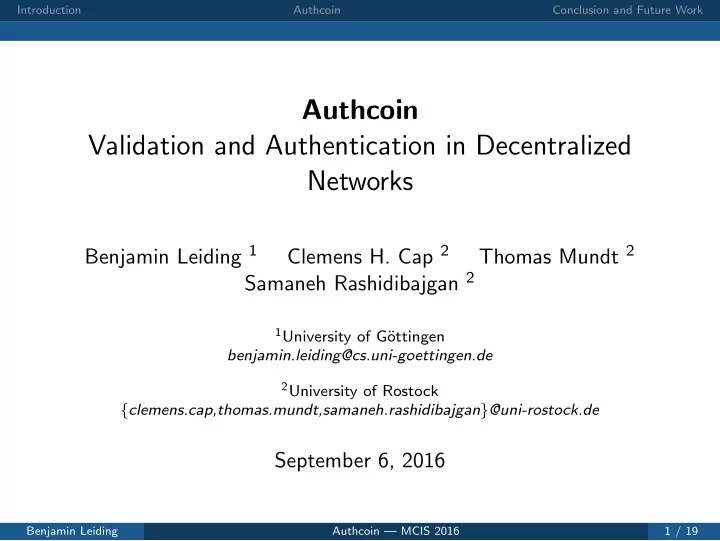

Introduction Authcoin Conclusion and Future Work Authcoin Validation and Authentication in Decentralized Networks Benjamin Leiding 1 Clemens H. Cap 2 Thomas Mundt 2 Samaneh Rashidibajgan 2 1 University of G¨ ottingen benjamin.leiding@cs.uni-goettingen.de 2 University of Rostock { clemens.cap,thomas.mundt,samaneh.rashidibajgan } @uni-rostock.de September 6, 2016 Benjamin Leiding Authcoin — MCIS 2016 1 / 19
Introduction Authcoin Conclusion and Future Work Overview 1 Introduction 2 Authcoin 3 Conclusion and Future Work Benjamin Leiding Authcoin — MCIS 2016 2 / 19
Introduction Authcoin Conclusion and Future Work Introduction Benjamin Leiding Authcoin — MCIS 2016 3 / 19
Introduction Authcoin Conclusion and Future Work Motivation Existing solutions • Certificate authorities (CAs) • PGP Web of Trust • Certcoin BUT: All of them suffer from several disadvantages. Benjamin Leiding Authcoin — MCIS 2016 4 / 19
Introduction Authcoin Conclusion and Future Work Certificate Authorities (CAs) Figure: Hierarchical trust model Benjamin Leiding Authcoin — MCIS 2016 5 / 19
Introduction Authcoin Conclusion and Future Work PGP Web of Trust • Decentralized trust model for public keys • Mainly used for encrypted email communication • Users sign other users’ public key using their own private key to certify authenticity • Interpreting each key as node and each signature as directed edge results in a directed graph → The PGP Web of Trust Figure: PGP Web of Trust Benjamin Leiding Authcoin — MCIS 2016 6 / 19
Introduction Authcoin Conclusion and Future Work Certcoin An alternative approach • PGP Web of Trust + Block chain = Certcoin • Shares similarities with Authcoin • Inherited almost all disadvantages of the PGP Web of Trust • Has not been implemented yet Benjamin Leiding Authcoin — MCIS 2016 7 / 19
Introduction Authcoin Conclusion and Future Work Authcoin Benjamin Leiding Authcoin — MCIS 2016 8 / 19
Introduction Authcoin Conclusion and Future Work Overview Benjamin Leiding Authcoin — MCIS 2016 9 / 19
Introduction Authcoin Conclusion and Future Work General Validation and Authentication Figure: General V&A procedure Benjamin Leiding Authcoin — MCIS 2016 10 / 19
Introduction Authcoin Conclusion and Future Work Validation and Authentication Validation 1 An entity has access to the email account (account validation) 2 Same entity has access to the public and private key (key validation) 3 The key pair corresponds to the tested email account (binding) Authentication • Verify the identity of the entity. Benjamin Leiding Authcoin — MCIS 2016 11 / 19
Introduction Authcoin Conclusion and Future Work Challenges Challenges in a Nutshell • Security depends on chosen challenges • Flexible and customizable (use case, threat level, available information) • Bidirectional validation and authentication • Varying complexity • Users have to interpret information Benjamin Leiding Authcoin — MCIS 2016 12 / 19
Introduction Authcoin Conclusion and Future Work Storing Information Block chain • Store keys, signatures, challenges, responses, etc • Utilize advantages of block chain-based storage: decentralized, distributed, fault tolerant, transparent, difficult to manipulate, etc. • Either setup own chain or utilize existing one (as Namecoin does) Benjamin Leiding Authcoin — MCIS 2016 13 / 19
Introduction Authcoin Conclusion and Future Work Overview Benjamin Leiding Authcoin — MCIS 2016 14 / 19
Introduction Authcoin Conclusion and Future Work Automated Validation and Authentication Requests Validation and Authentication Requests (VARs) • Automatically and randomly create with each new block • Number of generated VARs depends on number of valid keys in chain • Break into sybil collectives “by accident” Benjamin Leiding Authcoin — MCIS 2016 15 / 19
Introduction Authcoin Conclusion and Future Work Conclusion and Future Work Benjamin Leiding Authcoin — MCIS 2016 16 / 19
Introduction Authcoin Conclusion and Future Work Conclusion Conclusion • Highly flexible Challenge-Response-based V&A • Bidirectional V&A • Tamper-proof and transparent information storage (block chain) • More resilient against sybil node attacks than current solutions • No single point of failure Benjamin Leiding Authcoin — MCIS 2016 17 / 19
Introduction Authcoin Conclusion and Future Work Future Work Future Work • Implementation • API-based incentive system • Abstract from key pair use case • Biometric identifiers? Benjamin Leiding Authcoin — MCIS 2016 18 / 19
Introduction Authcoin Conclusion and Future Work Questions? Benjamin Leiding Authcoin — MCIS 2016 19 / 19
Recommend
More recommend